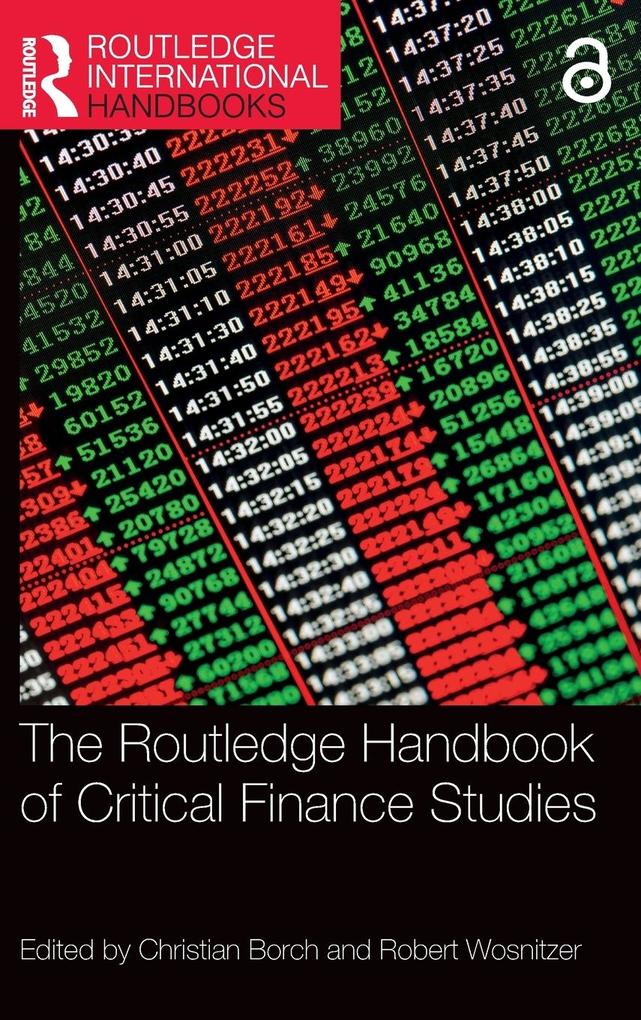
Zustellung: Mi, 21.05. - Sa, 24.05.
Versand in 1-2 Wochen
VersandkostenfreiBestellen & in Filiale abholen:
The term 'critical finance studies' remains largely unfocused and undefined. Against this backdrop, the key rationales of The Routledge Handbook to Critical Finance Studies are to provide a coherent notion of this emergent field and to demonstrate its analytical usefulness across a wide range of central aspects of contemporary finance.
Inhaltsverzeichnis
INTRODUCTION;
Christian Borch: What is Critical Finance Studies?;
PART I: KEY CONCEPTS;
Ch 1: Horacio Ortiz: Liquidity;
Ch 2: Benjamin Lee: Volatility;
Ch 3: Martijn Konings: Speculation;
Ch 4: Alex Preda: Financial Noise;
Ch 5: Carolyn Hardin and Adam Richard Rottinghaus: Risk and Arbitrage;
PART II: CENTRAL ACTORS AND INSTITUTIONS;
Ch 6: Nathan Coombs: Financial Regulation;
Ch 7: Clément Fontan and Louis Larue: Central Banking;
Ch 8: Angela Wigger and Rodrigo Fernandez: Shadow Banking and the Rise of Global Debt;
Ch 9: Yamina Tadjeddine: Financial Intermediaries;
Ch 10: Daniel Scott Souleles: Private Equity;
Ch 11: Ekaterina Svetlova: Financial Models;
Ch 12: Ann-Christina Lange: High-Frequency Trading;
PART III: FINANCIALIZATION;
Ch 13: Dick Bryan, David Harvie, Mike Rafferty and Bruno Tinel: The Financialized State;
Ch 14: Léna Pellandini-Simányi: The Financialization of Everyday Life;
Ch 15: José Ossandón: Consumer Credit and Credit Assessment;
Ch 16: Julian Hartman and Mark Kear: Critical Financial Geography;
Ch 17: Jing Wang: Fin-Tech;
Ch 18: Torsten Andreasen, Mikkel Krause Frantzen and Frederik Tygstrup: Finance Fiction;
Ch 19: Victoria Ivanova and Gerald Nestler: Art, Markets, and Finance;
Christian Borch: What is Critical Finance Studies?;
PART I: KEY CONCEPTS;
Ch 1: Horacio Ortiz: Liquidity;
Ch 2: Benjamin Lee: Volatility;
Ch 3: Martijn Konings: Speculation;
Ch 4: Alex Preda: Financial Noise;
Ch 5: Carolyn Hardin and Adam Richard Rottinghaus: Risk and Arbitrage;
PART II: CENTRAL ACTORS AND INSTITUTIONS;
Ch 6: Nathan Coombs: Financial Regulation;
Ch 7: Clément Fontan and Louis Larue: Central Banking;
Ch 8: Angela Wigger and Rodrigo Fernandez: Shadow Banking and the Rise of Global Debt;
Ch 9: Yamina Tadjeddine: Financial Intermediaries;
Ch 10: Daniel Scott Souleles: Private Equity;
Ch 11: Ekaterina Svetlova: Financial Models;
Ch 12: Ann-Christina Lange: High-Frequency Trading;
PART III: FINANCIALIZATION;
Ch 13: Dick Bryan, David Harvie, Mike Rafferty and Bruno Tinel: The Financialized State;
Ch 14: Léna Pellandini-Simányi: The Financialization of Everyday Life;
Ch 15: José Ossandón: Consumer Credit and Credit Assessment;
Ch 16: Julian Hartman and Mark Kear: Critical Financial Geography;
Ch 17: Jing Wang: Fin-Tech;
Ch 18: Torsten Andreasen, Mikkel Krause Frantzen and Frederik Tygstrup: Finance Fiction;
Ch 19: Victoria Ivanova and Gerald Nestler: Art, Markets, and Finance;
Produktdetails
Erscheinungsdatum
16. September 2020
Sprache
englisch
Seitenanzahl
444
Herausgegeben von
Christian Borch, Robert Wosnitzer
Verlag/Hersteller
Produktart
gebunden
Gewicht
790 g
Größe (L/B/H)
235/157/28 mm
ISBN
9781138079816
Entdecken Sie mehr
Bewertungen
0 Bewertungen
Es wurden noch keine Bewertungen abgegeben. Schreiben Sie die erste Bewertung zu "The Routledge Handbook of Critical Finance Studies" und helfen Sie damit anderen bei der Kaufentscheidung.











